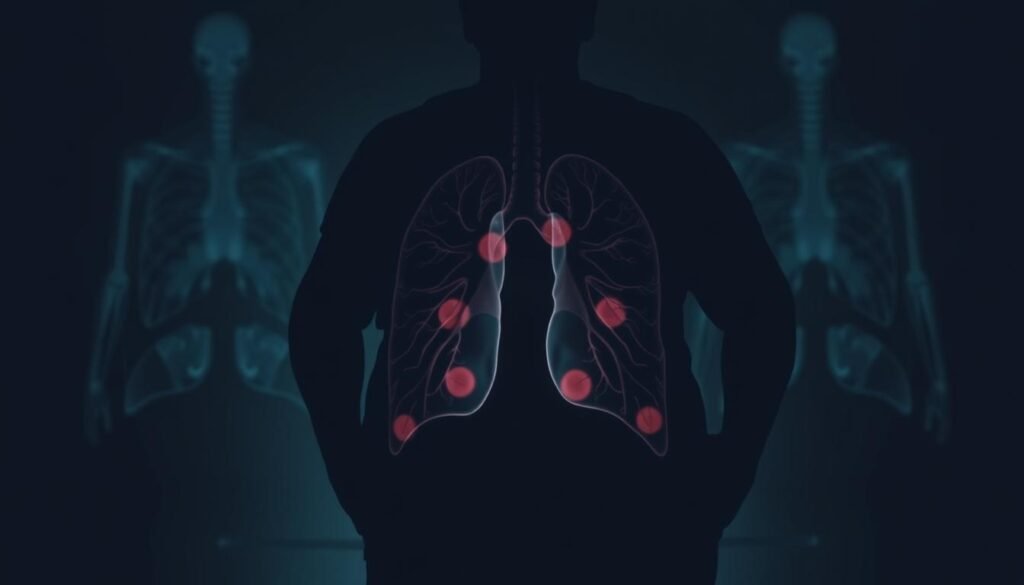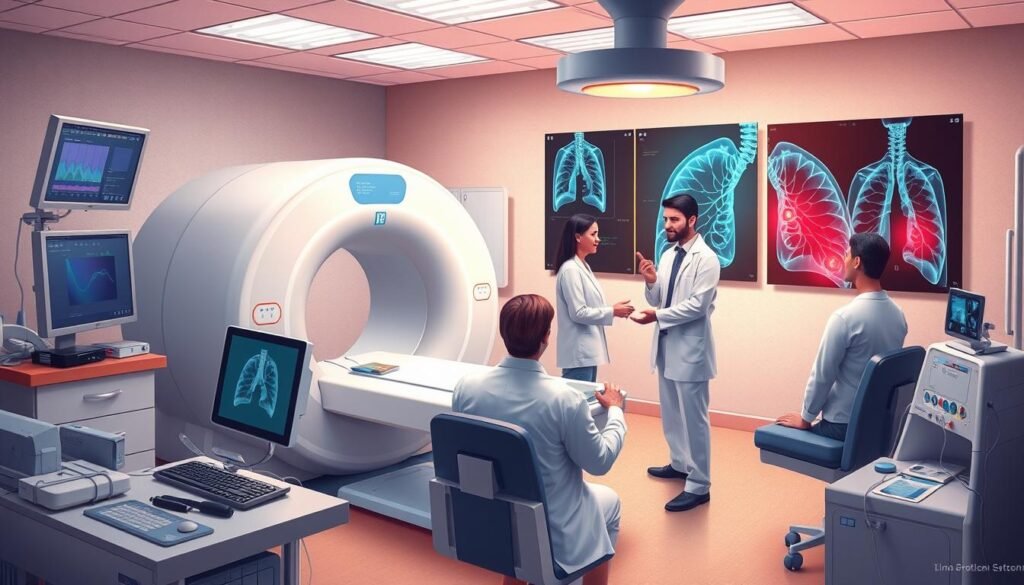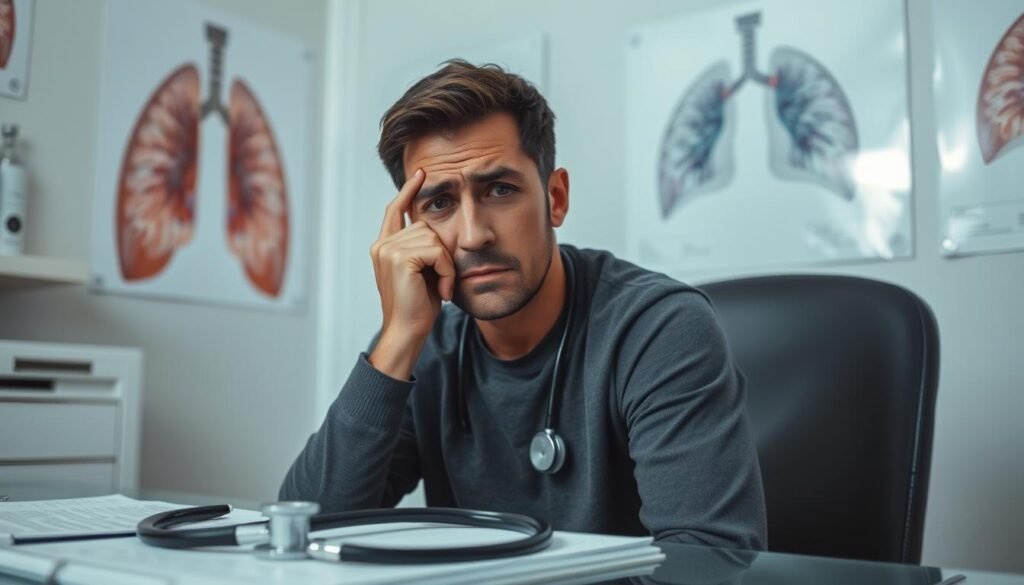Lung cancer causes nearly 25% of all cancer deaths in the United States. This fact highlights the need to recognize early signs of lung cancer. Knowing these signs can help catch the disease early when it’s easier to treat.
The number of lung cancer cases is growing. It’s essential for everyone to know the signs and symptoms. Being aware can lead to early detection and significantly improve treatment results.
Learning about the early signs of lung cancer is crucial. It allows people to seek medical help early, improving their treatment chances. Symptoms like a constant cough, losing weight without trying, or others should not be ignored. Acting early can make a big difference.
For detailed information, check out Care Your Lungs. This site offers valuable advice on spotting these important symptoms.
Key Takeaways
- Lung cancer is a major cause of cancer deaths.
- Detecting the disease early is key for better treatment success.
- Knowing the symptoms can prompt quicker medical consultation.
- It’s critical to recognize signs like an ongoing cough.
- There are resources to help understand lung cancer better.
Understanding Lung Cancer
Lung cancer is a serious illness where abnormal cells grow uncontrollably in the lungs. The lung cancer definition shows it can spread to other body parts if not caught early. Non-small cell lung cancer (NSCLC) and small cell lung cancer (SCLC) are the main types. They behave differently and need unique treatments.
Many factors can cause lung cancer. Smoking is the biggest risk. It greatly increases your chance of getting lung cancer. Secondhand smoke also increases risk, especially for those who don’t smoke. Radon gas, asbestos, and other environmental toxins can make lung cancer more likely too.
The following table outlines key differences between the types of lung cancer:
| Type of Lung Cancer | Characteristics | Risk Factors |
|---|---|---|
| Non-Small Cell Lung Cancer (NSCLC) | Most common type, grows slowly | Smoking, secondhand smoke, pollution |
| Small Cell Lung Cancer (SCLC) | Less common, more aggressive | Strongly linked to smoking |
Knowing the types of lung cancer is key to early detection and treatment. Regular check-ups and knowing the symptoms are vital. It’s very important to learn about lung cancer causes and understand the risks.
Common Signs and Symptoms of Lung Cancer
It’s important to catch lung cancer early for the best chance at treatment. The main signs include a continuous cough, chest pain, and trouble breathing. Knowing these signs helps keep an eye on your lung health.
Persistent Cough
A cough that doesn’t go away might be a lung cancer sign. It’s different from other coughs because it lasts a long time and gets worse. If you notice it changing or happening more often, especially with other symptoms, it’s time to see a doctor.
Chest Pain
If you have chest pain that’s getting worse or happens more often, it could be serious. This kind of pain may mean lung cancer is spreading to nearby areas. It can be a little uncomfortable or very painful, making daily life hard.
Shortness of Breath
Feeling out of breath easily is a big warning sign. Some people might struggle to breathe even when they’re sitting still or doing simple activities. Knowing this can help you get medical advice early on.
| Symptom | Description |
|---|---|
| Persistent Cough | Lasts weeks; may worsen over time |
| Chest Pain | Can indicate progression; ranges from mild to severe |
| Shortness of Breath | Affects daily activities; can occur at rest |
Signs and Symptoms of Lung Cancer
Coughing up blood and hoarseness can mean lung cancer is in advanced stages. It’s vital to notice these symptoms for early treatment.
Coughing Up Blood
Coughing up blood is alarming. It happens when tumors affect the lungs’ blood vessels. If you see this, get medical help right away. Not doing so can make things much worse.
Hoarseness
Hoarseness is important too. It could mean the cancer is near the vocal cords. Always check with a doctor if your voice stays raspy. Early action may lead to better treatment.
Impact of Weight Loss on Lung Cancer Diagnosis
Unexplained weight loss is a key alert for several cancers, especially lung cancer. Studies show that losing a lot of weight, about 10% to 50%, before being diagnosed can make lung cancer more likely. This shows why it’s vital to watch for any weight changes, especially with symptoms of lung cancer like losing appetite or feeling very tired.
Cancer can cause weight loss without trying. This happens when tumors release chemicals that change how the body uses energy, leading to weight loss. If you’re losing weight and have other symptoms of lung cancer, it’s important to see a doctor soon.
Knowing how weight loss and lung cancer are linked helps with early detection. Doctors stress the need for full exams for those losing a lot of weight. Early checks can find cancer sooner, which may lead to better treatment options.
| Weight Loss Percentage | Increased Risk of Lung Cancer Diagnosis |
|---|---|
| Less than 10% | Minimal Increase |
| 10% to 20% | Moderate Increase |
| 20% to 50% | Significant Increase |

Being aware of unexplained weight loss as a warning sign of lung cancer is crucial. It encourages self-monitoring and acting fast by talking to doctors. This can lead to the right tests and treatments early on.
For more details, check out a study that links weight loss and lung cancer closely. It stresses the importance of noticing these early signs.
Fatigue: A Notable Symptom
Lung cancer fatigue is a common challenge. It’s more intense and lasting than normal tiredness. It greatly affects everyday life and happiness.
This type of fatigue comes from several sources. The fight against cancer drains energy. Chemotherapy and radiation add to the tiredness. Knowing about this fatigue is key to handle it well.
It’s important to deal with lung cancer fatigue. Doing so helps both the body and mind. Simple steps like a healthy diet, light workouts, and managing stress help. Talking with doctors about how tired you feel can also bring better care and advice.
The Importance of Lung Cancer Screening
Lung cancer screening is key for catching the disease early. This is crucial especially for those at high risk. Smokers or people with a family history of lung cancer should pay attention. Getting screened regularly can find cancer early and improve survival chances a lot.
Who Should Get Screened?
High-risk groups should think about getting a lung cancer screening. This includes people aged 50 to 80 who smoked a lot. If you quit smoking recently or have family with lung cancer, consider screening. Talk with your doctor to understand your risks and decide about screening.
Screening Methods
Low-dose computed tomography (LDCT) is top for screening lung cancer. It makes detailed lung images, spotting possible tumors early. However, it’s not perfect. It can give false alarms and exposes you to some radiation. Discuss with your doctor about LDCT’s benefits and its risks for peace of mind.

| Screening Method | Benefits | Risks |
|---|---|---|
| Low-Dose CT Scan | Early detection of lung cancer, improved treatment options | Possible false positives, radiation exposure |
| X-Ray | Non-invasive, widely available | Lower sensitivity in early detection |
| Biopsy | Provides definitive diagnosis | Invasive procedure, potential complications |
Looking at your choices? Chat with a health expert. Learn about who should get screened and what methods are best. Talking to a doctor helps you understand lung cancer detection better.
Other Respiratory Symptoms to Be Aware Of
Knowing about lung cancer symptoms is important. It’s not just about the common signs. Wheezing is a key symptom to watch out for. It means there might be a blockage or swelling in the airways. A whistling noise when you breathe can be your sign to get checked out.
Recurrent respiratory infections are another red flag for lung cancer. If you keep getting bronchitis or pneumonia, it may be a sign your lungs are in trouble. These infections can harm your breathing over time.
Beware if your breathing changes during normal activities. If you get short of breath doing things that used to be easy, it could mean lung troubles. That’s a sign you should see a doctor.
If you notice these symptoms, it’s crucial to pay attention to your health. Don’t wait to seek medical advice if these symptoms show up.
| Symptom | Description |
|---|---|
| Wheezing | A high-pitched whistling sound during breathing, indicating possible airway obstruction. |
| Recurrent Infections | Frequent respiratory infections such as bronchitis or pneumonia may indicate underlying issues. |
| Changes in Breathing Patterns | Shortness of breath during activities that were previously manageable can signal lung problems. |
When to See a Doctor
Knowing when to see a doctor for lung cancer is very important. It can change the outcome. Seeing a doctor quickly when symptoms show up is key. Watch for signs that mean you need help right away.
Recognizing Urgency
Some symptoms should make you see a doctor soon. These include:
- Persistent coughing that doesn’t get better
- Unexpected weight loss
- Severe chest pain
- Coughing up blood or rust-colored spit
- Hard time breathing or wheezing
If you notice any of these, it’s time to get checked. Acting fast helps diagnose the problem early. This improves your treatment options. For more info on when to get help, check out early signs and symptoms of lung cancer.

Risk Factors Influencing Lung Cancer
Understanding lung cancer risk factors is vital. It helps in prevention and early spotting of the disease. Many elements greatly affect lung cancer risks.
Smoking is a top cause. It includes both active smoking and inhaling secondhand smoke. These actions highly increase lung cancer risks due to harmful substances in tobacco smoke.
Next up is radon gas exposure. This harmful gas comes from natural uranium decay in soil and rocks. It can build up in places like basements, upping lung cancer risks.
Being around asbestos is also dangerous. This substance was widely used in building materials. People in certain jobs are at a higher risk, especially smokers.
Pollution plays a big role, too. Tiny pollution particles from cars and factories affect the lungs. More pollution means a higher chance of getting lung cancer.
Genes matter as well. If lung cancer runs in the family, you might be more prone to it. Knowing your family health history is key.
Finally, the way you live makes a difference. Eating well and exercising can combat lung cancer risks. Healthier choices lead to better lung health.
| Risk Factor | Description | Influence Level |
|---|---|---|
| Smoking | Active and passive exposure to tobacco smoke. | Very High |
| Radon Exposure | Natural gas accumulation in indoor environments. | High |
| Asbestos | Exposure during construction or demolition tasks. | High |
| Air Pollution | Fine particulate matter from various sources. | Moderate |
| Genetic Predisposition | Family history of lung cancer. | Moderate |
| Lifestyle Choices | Diet and exercise impact overall lung health. | Variable |
Conclusion
Knowing the signs of lung cancer is very important for health. This article talked about key signs like lasting cough, chest pain, and spitting up blood. Catching lung cancer early can really help with treatment and outcomes.
A feeling of tiredness, losing weight, and breathing problems could mean lung cancer. It’s key to notice these signs early. Knowing this helps people talk to doctors sooner. Learning about these signs is very important for getting help quickly.
Raising awareness about the early signs of lung cancer helps everyone, not just those at risk. Staying alert to changes in health is crucial. Quick medical help can make a big difference in fighting lung cancer. Being well-informed and ready is vital in this battle.